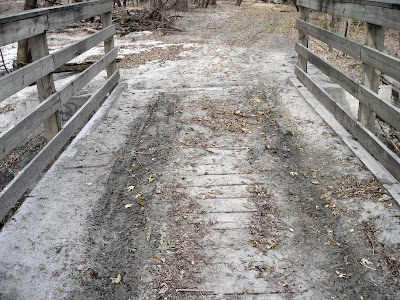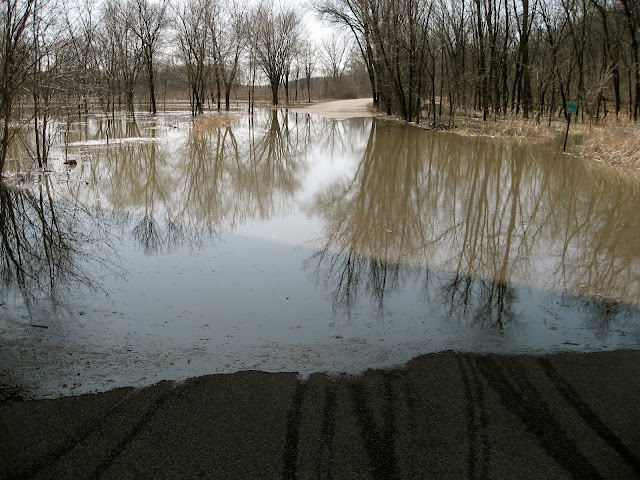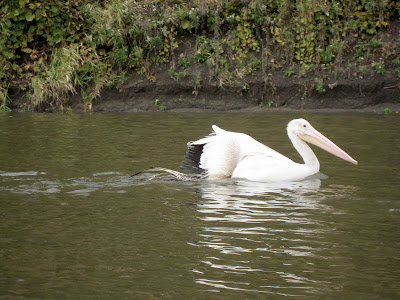
The first part of the ride was a piece of cake. That's the part where I ride a few blocks, pay less than two dollars, board an LRT train where I hang my bike inside on the conveniently provided hanger, and relax as we are carried south to Bloomington. In fact this part of the ride is even easier than before, seeing as there is a new station in the median at American Boulevard, allowing me to hop out for an even shorter ride to the Wildlife Area. In fact the ride down the hill behind the visitor center is easier than ever (often I have to walk at least part of this because of deep, loose gravel or ruts) and I am able to coast slowly down the whole length of it and casually grab the trail southward.
From here I'm assuming things will get harder. The only question is how much harder. I have two basic motivations for this ride on this day. First is the fact that this is probably my favorite ride and I haven't done it all year. High water, knee issues, and other factors have kept me away, and I've been waiting for months now for the right opportunity. Today seems to be it, what with the unseasonably warm weather. The catch is that we did get a fair amount of rain earlier in the week, and record windstorms to boot (an "inland hurricane" as one person dubbed it) so I'm not sure what the trail conditions will be like. I'm expecting some downed trees and some mud, but hoping it is passable, hoping it is ride-able. My other motivation for the ride was spurred by some of the e-mails I've been reading from the list serve of the Minnesota Ornithologists' Union. Amongst the rarities (common ground dove, pacific loon, Ferruginous Hawk, Long-tailed Jaeger, etc., I noticed a few mentions of Wigeons, and that reminded my of my beloved Wigeon pond near the highway 77 turnaround on this trail. Would I ever relish the chance to spot a wigeon down there, if it's not too late!
I set out down the old gravel road, encouraged ... no problems with the riding surface at those first two stream crossings. I stopped at the second, where the water was truly surging, looking for birdlife and surveying the bald eagle's nest off int he distance for any signs of activity. Nothing. But I was away from home, away from traffic, and finally on my ride. Before long I hit the first obstacle: a completely flooded section of trail. I surprised myself, though, by being able to power through the muddy grasses along the shoulder in my easiest gear by keeping high pedal rotation speeds.
From there the going got worse. It had nothing to do with the recent rains. No, I'm sure it was the intense spring and fall floods this year that had the Minnesota River well out of its banks. The park staff had obviously been down here trying to rehabilitate the trail. There were signs of new dirt and rebuilt road: treads from earth-moving utility equipment marked the road at regular intervals. These were not just like tire treads, but more like a tank, carving deep notches in the trail surface. The trail was plenty dry enough here, but those notches created a strong washboard effect, and with my steel-framed bike I was rattled from so much bumpy vibration.
Silly of me to complain about that though, as I would soon find out. At least it was ride-able. I had expected downed trees, mud, and maybe some standing water. I had not expected something worse: sand. Yes, the river had deposited inches of sand, filling in the trailbed in long stretches. In this next stretch it was too deep to pedal through, so I was reduced to walking. It was becoming a struggle already, and I was only perhaps a quarter of the way into the ride. So already I faced that first decision point. I could turn back and deal with the unpleasant but passable trail, or I could forge ahead, hoping for better conditions but facing what might be much worse. No one else was on the trail; the only soul around was a white-tailed deer foraging nearby. I forged ahead, thinking of the wigeons.
The area around the 77 bridge was pretty well flooded still, but I was able to power through on my thoroughly mud-caked tires. I made it up the first leg of the bike bridge ramp, and things got so much better. Within a minute I was riding on rubber again. I rode over the put-in spot for a favored paddling outing, noting how far the water went up onto the boat ramp. I still didn't understand what happened this fall. It seemed that at the same time we were being told that we were int he midst of a record dry streak, with no rain for months in the TC, we were getting record flood warnings on the Minnesota River; they even closed the St. Paul airport at one point. But statistics were of no matter to me now -- I was hunting for Wigeons. I approached The Wigeon Pond from a new vantage point on the south side.
There were plenty of swimmers there, but they all had solid green heads -- Mallards. I biked up the hill a bit and pulled out my binoculars, scanning the pond. Wigeons! Yes, there were at least three males and two females toward the back of the pond. I spent some time watching one preening male whose yellow, green and brown feathers and pale blue bill were gleaming in the strong southern sunshine. In this same vicinity I also came across a couple of Great Blue Herons -- I was surprised there were still some around seeing as how it was almost November.
Reinvigorated, it was time to get on with the ride. I had convinced myself that the east side of the river would promise better riding conditions because of the well established, low wetlands nearby and deep streambeds connecting them to the river, plus the high riverbank. That's how I remembered it. And indeed, the first stretch was a little soft, a little wet, a little soupy, yet quite ride-able.
Undated warning sign
Then: the sun went behind the clouds. Lots of downed trees and branches. Deep Mud. Worst of all, deep, deep river sand. I was back to intermittent walking, tripping through branch fragments, trying to keep my ankles dry. Deep tire ruts – someone, maybe park staff, had driven a truck through the mud – didn't help. It was one of those rare occasions when I wished I was riding a mountain bike. Yes, easier gears and increased tire-ground surface contact would have helped here. But as always I was on my cyclocross bike, which under normal circumstances was ideal for this trail. Anyway, I wasn't going to turn back now, not after struggling down the west riverbank. I wasn't going to bike back that way.
I came a cross a middle-aged woman hiking in an area seemingly inaccessible by car. I don't know how she got there, unless she'd actually hiked all the way from the parking area under the 77 bridge, which was pretty far behind me. She lamented the poor trail conditions, pointing out that it was especially bad for biking. I asked if she'd seen the trail downriver, and if so, what the outlook was. She had, and she gave a decidedly discouraging forecast: downed trees, mud, and yes, lots and lots of sand. That confounded grey river sand.
Not November Snow – October Sand
But I wasn't about to let this estranged hiker take the wind out of my sails. I forged ahead. Ahead into worse and worse conditions, tripping, sliding, and sinking. Nearly falling off of the bike. Hiking with the bike where hiking alone was difficult. Cloudy skies, standing water, puddles, blown-out bridges, and finally that spot I dreaded, where the trail started to merge with the river itself.
I forged ahead. I was committed. And I could scarcely believe it, but things were getting better, with long stretches of ride-able trail. Sure, there were wet spots, soft spots, and sandy stretches, but nothing I couldn't handle. By the time I reached a raccoon watering hole under the I-494 bridge, things were looking much brighter, figuratively and literally.
The sun was shining, and I finally got a stretch of trail that was easy going, so easy that I notched it up, not one gear, but two or three -- I was actually cruising, and cruised all the way into the village of Mendota. Yes, I was back to civilization and riding on rubber again. Rubber and pavement; things could not have been more effortless.
In fact it was warm and sunny. In fact I cruised by Sea Salt on my way back home. In fact I happened upon an old friend there, sitting alone outside on the sunny terrace. I pulled my bike up, sat down, and in response to his inquiry, began to tell him about my ride: "The first part of the ride was a piece of cake. .."























































